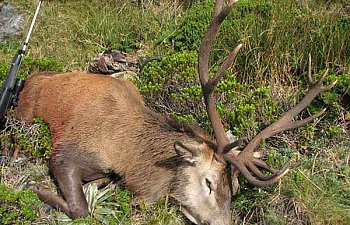WAPITI HUNTING IN NEW ZEALAND
By Greg Duley
My annual pilgrimage to the Fiordland Mountains hunting wapiti (elk) during the bugle took me to the Loch Burn block in April this year. I had been guiding deer hunters for the previous month and was really looking forward to a couple of weeks of hunting and exploring on my own account. Hunting in this wilderness area requires extreme fitness and mountain knowledge due to the rugged terrain and atrocious weather that may be encountered. Starting from the edge of Lake Te Anau which is about sea level, you then have to carry everything you need for two weeks on your back 5,000 to 6,000 feet up into the mountains. The wapiti live high and are only driven off the tops by heavy snowfalls in winter. This is the only area in New Zealand where wapiti live. Unfortunately red deer infiltrate the area and then interbreed with the wapiti creating a smaller crossbreed animal, so we try and shoot as many red type animals as we can without disturbing the wapiti too much.
[floatright]
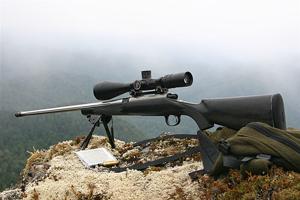 [/floatright]With weight and space at a premium, this is exactly the sort of hunting trip we had in mind when my son Jamie and I designed the 7mm Fatso. This cartridge is based on a 338 Lapua magnum necked down to 7mm and shortened to the same body length as a Winchester Short Magnum. This creates the ultimate Short Magnum giving 7mm STW ballistics out of a lightweight short actioned rifle weighing just over 7 pounds all up including scope. The action on this particular rifle is a trued Remington Titanium with the bolt face opened up, Sako extractor fitted and magazine lengthened. More weight is saved with a Gre-Tan speed lock alloy firing pin and alloy bolt shroud and Rifle Basix alloy housing three lever trigger. The barrel is a 26 inch number 4 contour fluted Lilja with a 1 in 9 twist. The stock is a McMillan Hunters Edge. The Leupold 4.5-14x50 LR Mark 4 sits in those exquisite Nightforce low alloy rings with the titanium clamps on a one-piece alloy base. This picture was taken before I had mounted the lighter scope. The load for the long shots is a 162gn A-Max doing 3250 fps, and the BC works out at .650 out of this rifle. You can push this bullet at 3300 fps but the groups open up to over .5 MOA whereas at this velocity they'll shoot .4 MOA which is pretty good for such a light rifle. For the under 500 yards shots a 160gn Accubond (BC .525) at 3300 fps works superbly, and averages .5 to .6 MOA.
[/floatright]With weight and space at a premium, this is exactly the sort of hunting trip we had in mind when my son Jamie and I designed the 7mm Fatso. This cartridge is based on a 338 Lapua magnum necked down to 7mm and shortened to the same body length as a Winchester Short Magnum. This creates the ultimate Short Magnum giving 7mm STW ballistics out of a lightweight short actioned rifle weighing just over 7 pounds all up including scope. The action on this particular rifle is a trued Remington Titanium with the bolt face opened up, Sako extractor fitted and magazine lengthened. More weight is saved with a Gre-Tan speed lock alloy firing pin and alloy bolt shroud and Rifle Basix alloy housing three lever trigger. The barrel is a 26 inch number 4 contour fluted Lilja with a 1 in 9 twist. The stock is a McMillan Hunters Edge. The Leupold 4.5-14x50 LR Mark 4 sits in those exquisite Nightforce low alloy rings with the titanium clamps on a one-piece alloy base. This picture was taken before I had mounted the lighter scope. The load for the long shots is a 162gn A-Max doing 3250 fps, and the BC works out at .650 out of this rifle. You can push this bullet at 3300 fps but the groups open up to over .5 MOA whereas at this velocity they'll shoot .4 MOA which is pretty good for such a light rifle. For the under 500 yards shots a 160gn Accubond (BC .525) at 3300 fps works superbly, and averages .5 to .6 MOA.
Both my boys were busy at school and the wapiti bugle unfortunately isn't during their holidays. I took Neil Philpott with me again as he's done a couple of wapiti trips with me now. Friends of mine from Te Anau, Frank and Neil, took us across the lake in Neil's launch one afternoon. We spent our last night of comfort for two weeks eating, drinking and sleeping on the launch before climbing over the side and starting our ascent with heavy packs.
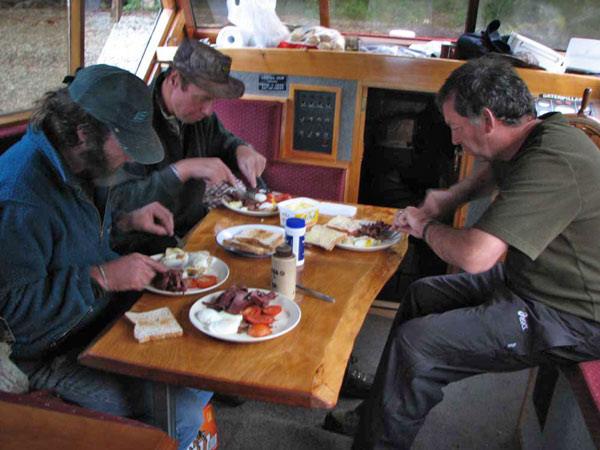
Our last luxury breakfast, bacon and eggs before the start of the big climb.
We climbed continuously up through the beech forest for four hours until we broke out onto the open mountain tops south of an area called Howlett's peaks. The weather was windy, squally and pretty cold. We spent a couple of days hunting this mountain range until the weather forecast on the mountain radio said a large storm was approaching.
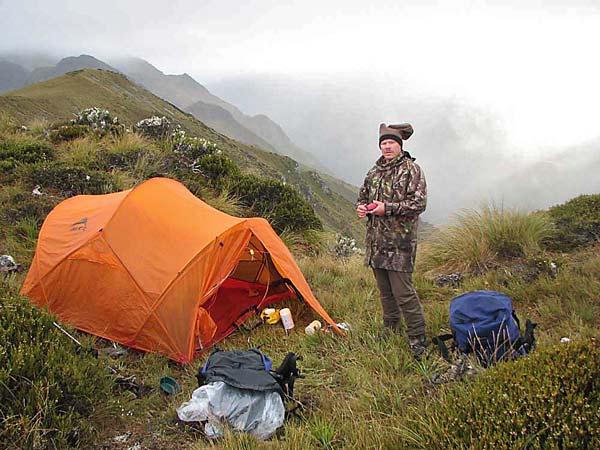
Neil at our first high camp site with no shelter.
We had seen predominantly red deer in this area and few wapiti type animals. Deciding to head back down to a lower level to weather the storm, we set off back down to the lake edge well north from where we had come up. On the way I culled a couple of red deer, a hind and a young stag. They had appeared up the other side of a steep valley we were skirting around. Sitting down and shooting off my knees I dropped them both with a shot apiece after the rangefinder told me they were 350 yards away using the 160 grain Accubond load. The hind dropped on the spot to the first shot and the stag reared up and rolled backwards to end up right next to her.
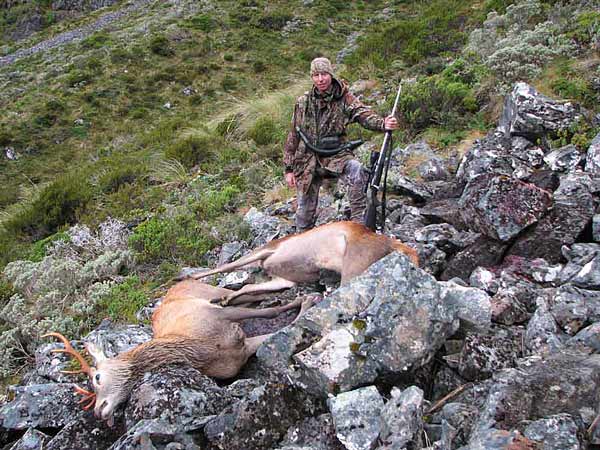
A mature red type hind and young stag I culled on our way back off the tops before the first storm.
[/floatright]
After taking their jaws for research purposes we picked up the speed of our descent down through the beech forest as we were running out of daylight. Hitting the lake shore right on dark, we unfortunately had a nightmare of a trip climbing up and down bush covered bluffs by torchlight to make our way around the edge of the lake to the start of a sandy beach. This we followed for a couple of miles which took us around to where we left the main lake and headed over an isthmus (narrow piece of land between two water bodies) to the start of Lake Hankinson. Now after midnight, we launched the dinghy which is kept there, started the outboard motor that Frank had lent us and headed off up the lake in the pitch black. The storm was due to hit in the early hours of the morning, and I wanted to get to the hut at the top end of the lake before it got too rough to travel up it. An hour later we hit the beach at the top end, tied up the boat and carried our gear to the hut, arriving there at 2 a.m., exhausted. We woke up a couple of bow hunters who were in residence and they boiled the billy and made us a cuppa, then we all hit the sack.
It was satisfying to sleep in the next morning in the comfort of the hut as the storm raged around us. It blew itself out by evening, so the next morning we put 10 days food in our packs and headed off up the true left of Canyon Creek to try and find our way onto the tops between there and the Lugar Burn (Burn is a Scottish name for valley). After climbing all day, we broke out of the beech forest and continued up until we reached a terrace just underneath the highest peak and set up camp at 5500 feet. For the next few days we hunted south covering some treacherous terrain until we reached the Howlett's peaks area we had hunted at the beginning of the trip.
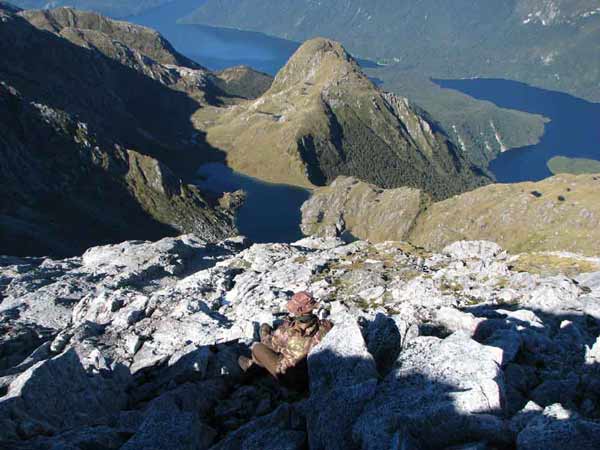
Looking down on the isthmus between Lake Te Anau on the left and LakeHankinson on the right from Howlett's peaks.

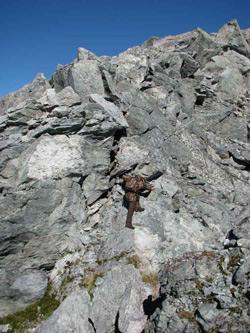
Interesting country!
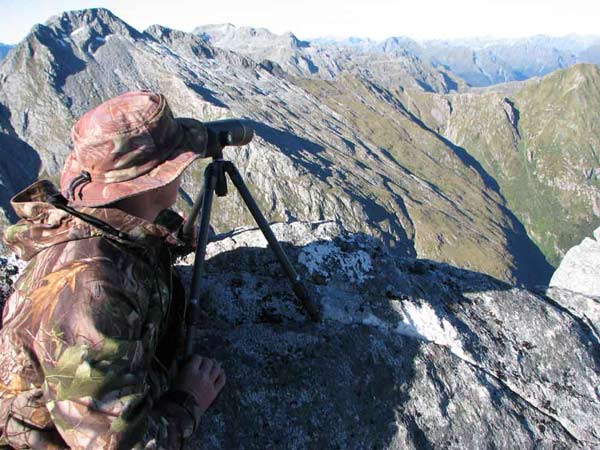
Neil watching a mature bull through the spotter.
We saw a reasonable number of wapiti type animals including several young bulls and one mature bull but nothing better than trophies we had previously taken. Packing up the next morning we headed north and dropped down into an area where I had seen a pretty good 15 pointer (8x7) two years previously. The weather was packing in again unfortunately and low cloud and rain made visibility difficult, but the only animal encountered was a 10 pointer (5x5) of average size in the Austral Creek saddle that I managed to get a few photos of.
With another big storm forecast we managed to find a sheltered camp site behind some large rocks on a higher terrace. The wind raged and the rain fell all the following day but our carefully chosen camp didn't let us down and we emerged to a calm but cloudy day the next morning. Heading north again we spent a frustrating day on the more accessible tops above the Lugar Burn flats, bumping into animals in the low cloud and not being able to see how big they were.
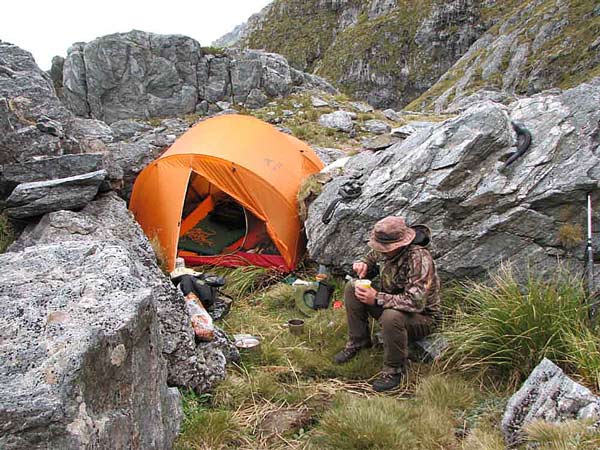
A hard to find high sheltered camp site that allowed us to weather the second storm.
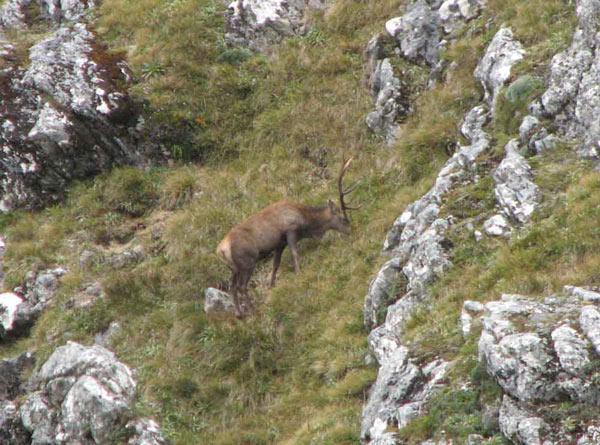
The reasonable 10 pointer in the Austral Creek saddle.
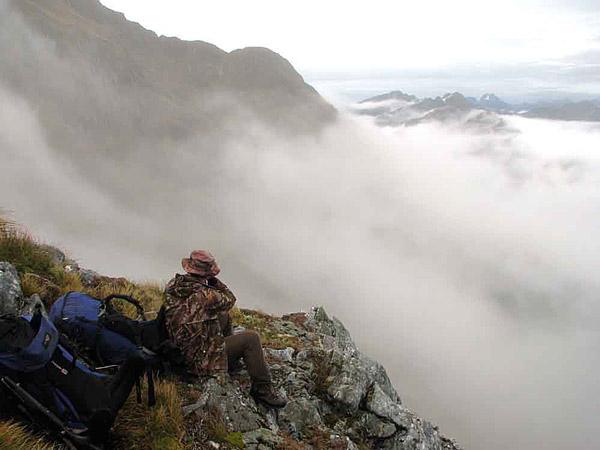
The frustrating cloud that made locating animals a matter of luck.
Leaving Neil who was complaining about his knee, I dropped several thousand feet down into the Lugar Burn to try and find my John Nosler presentation Gerber folding knife that Neil had lost two years previously when we were caping his big bull. I found the bones but they were scattered for some distance by avalanches from the heavy winter snows and it was obvious it would be a sheer fluke if I found my knife. I climbed back up and eventually joined Neil who was trying to assess a big bull in the head of the Lugar Burn through my spotter.
The cloud just would not play the game so we had to carry on as the day was getting on. We made a nerve wracking descent down into the start of Canyon Creek?s north cirque (circular ring of cliffs at the head of the valley formed by glaciers), unsure in the poor visibility whether we were going to be able to get to the bottom. Thankfully, by nightfall we had negotiated our way down the last bluff and set up camp in some ribbonwood guts at the start of the best deer country. Through gaps in the cloud we had seen several bulls and cows on the feed slopes beneath the cliffs in the head of the north cirque. When I bugled from the tent that night, some powerful replies echoed back down the valley.
The next morning we headed up onto a prominent ridge that gave us a good view of the north cirque only to find during the night the animals had traveled a sidle track round and into the south cirque. All that was left in the north cirque was a couple of young bulls.
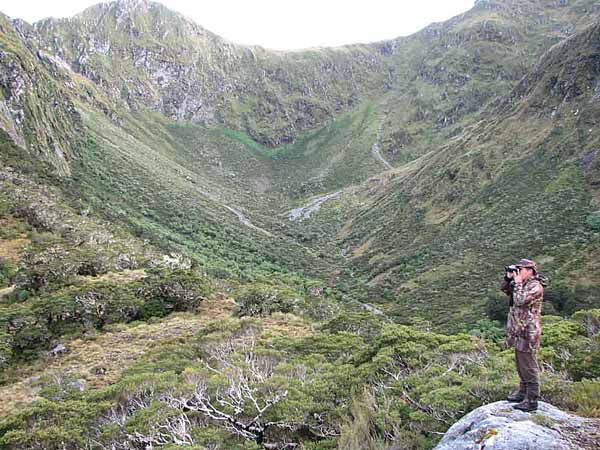
The North cirque of Canyon Creek from the prominent ridge.
Climbing some cliffs and sidling our way around to a good lookout above the south cirque, we dropped down on a herd of wapiti cows and calves with a mature bull in attendance. He was doing his best to keep some red stags at bay, so even though his trophy quality wasn't really good enough we left him covering the cows rather than letting them in on the act.
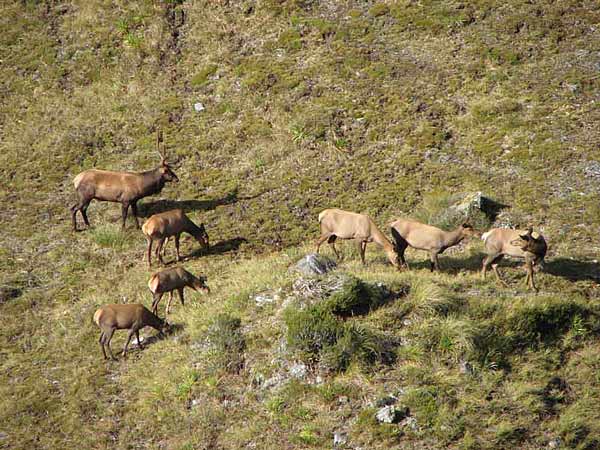
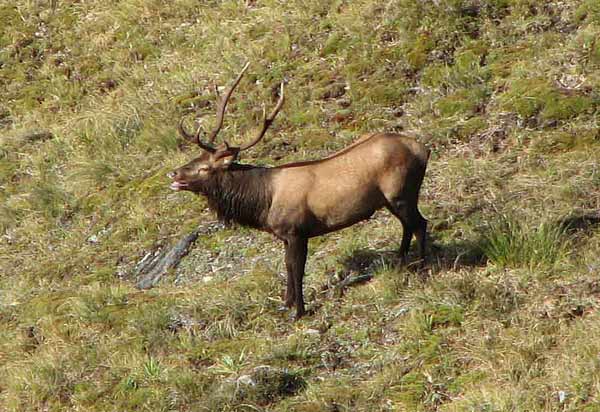
The bugling wapiti bull and some of his cows.
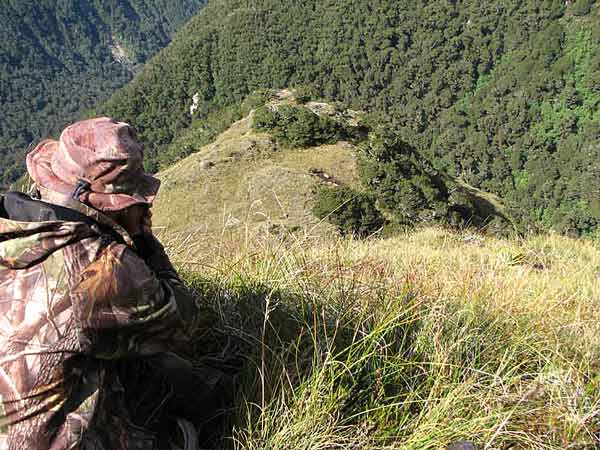
Neil glassing the little wapiti herd.
Hearing some red roars echoing down from on high to the south, I eventually picked up a large red stag holding four cows high up above the pass out of the south cirque over into the WapitiRiver. I decided he really needed culling so left Neil and his dodgy knee and started the climb. After making good progress for an hour and a half straight up, I tried to cut around onto the rim of the cirque to take me round past the last mountain to the high pass. Unfortunately, a cataract separated us and forced me to have to climb right to the top before I could cut over to the WapitiRiver side to get around it. Finally cresting the top, I looked over and saw a couple of animals feeding on the terrace below me, one a young red stag but the other a nice young 12 point wapiti bull. I took a couple of photos then dropped the red stag with a 160 Accubond but the young wapiti just stood around waiting for his mate. In this remote area, these animals very rarely see humans and the sight of us of doesn't alarm them unduly. Smell, well that's a different story! One whiff of human scent and they travel for miles vacating whole watersheds to get away!
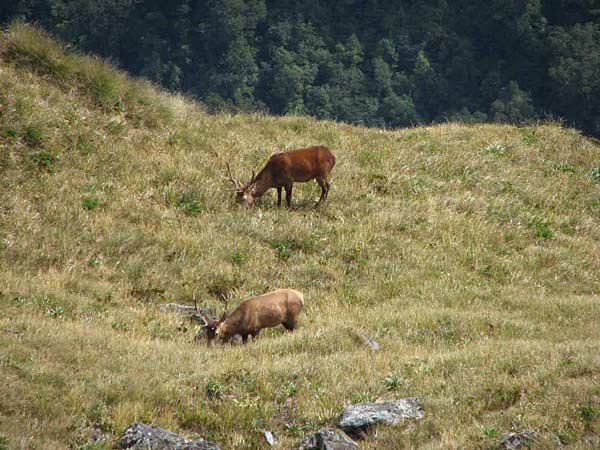
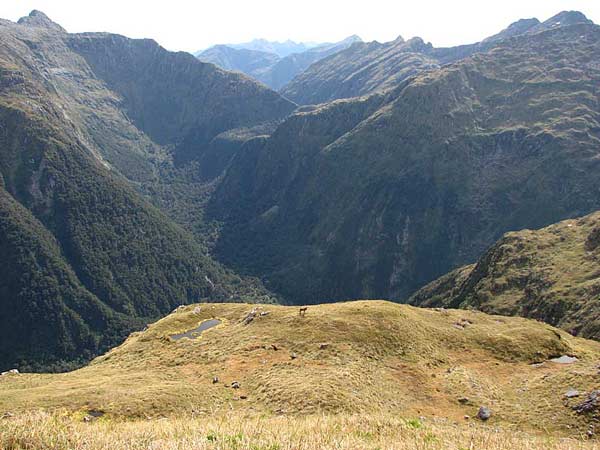
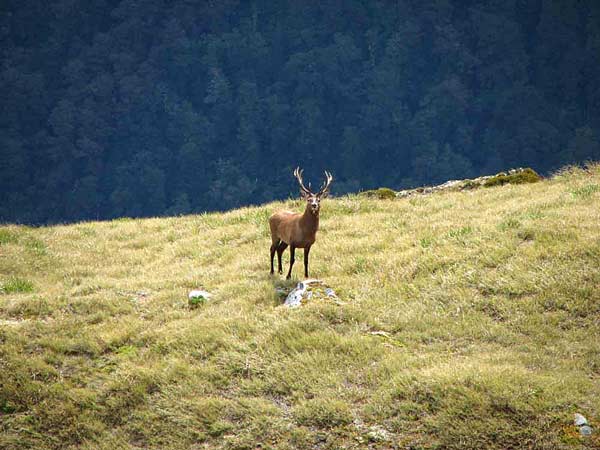
A two-year-old wapiti and red stag grazing together on the tops above LakeSutherland in the WapitiRiver. I culled the young red stag and the young 12 point wapiti stood waiting for his mate to catch up for ages.
I carried on around until the last peak before the pass over to the red stag and cows. Making sure they were still there I looked around until I found a position where I could get a shot but the range was still long with the stag being 618 yards away. I could not drop down through the pass to get closer without being spotted so took the shot off the bipod and a good rest from where I was. Dialing 8.5 moa for the range and 2 moa for the 10mph wind blowing through the pass, I aimed at the crease just behind the shoulder of the stag when he was broadside sniffing one of the cows. One advantage of shooting at this range is that due to the bullet's time of flight you can muscle the rifle back into position and watch it hit. Shot right where I aimed with the 162 grain A-Max load, the stag took a couple of steps and then tumbled which worried me as a few yards further and he would've fallen over a 1,000 foot drop. Luckily he came to rest before that.
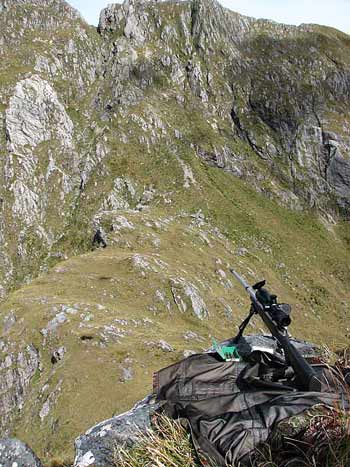
Looking 618 yards across the pass to where the red stag was holding four wapiti cows.

The ultimate lightweight long-range hunting rifle, the 7mm Fatso after the shot.
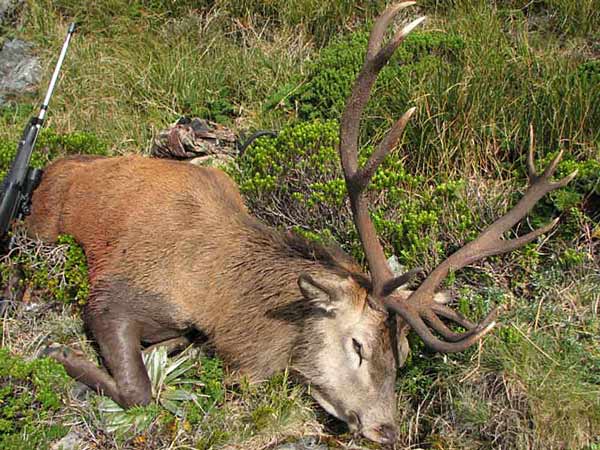
The 11 point red type stag, he has some wapiti blood in him but is not the sort of animal we want breeding.
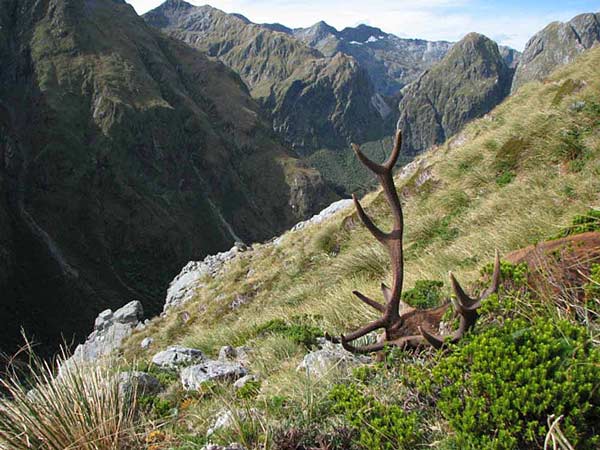
He came to rest just short of a large freefall thousands of feet down into the South cirque of Canyon Creek.
Taking his head I started the long journey back to where I had left Neil. I got there to find he had headed back to camp and I finally made camp just after dark. We were due to be picked up at the head of the main lake late the next day so the next morning we packed up early and I tied the head and antlers on top of my already heavy pack and we set off down Canyon Creek. The going wasn't too bad until we hit the bottom clearing and the start of the huge cataract from which this valley gets its name. Not having come up this way, we were unsure where the wapiti trail was that would take us around this cataract, or in fact if there even was one. We climbed hand over fist up a large overgrown slip for about an hour which was diabolical with the antlers strapped to my pack getting caught on everything, until we were able to burst over the top and begin sidling. Here and there we picked up bits of old trail and eventually began the descent to bring us back down into the WapitiRiver valley. On down the valley past Hankinson hut and eventually to the shores of LakeHankinson where we had left our dingy tied up. I was thankful to finally be able to drop my load at the lake edge and let the boat do the carrying from here!
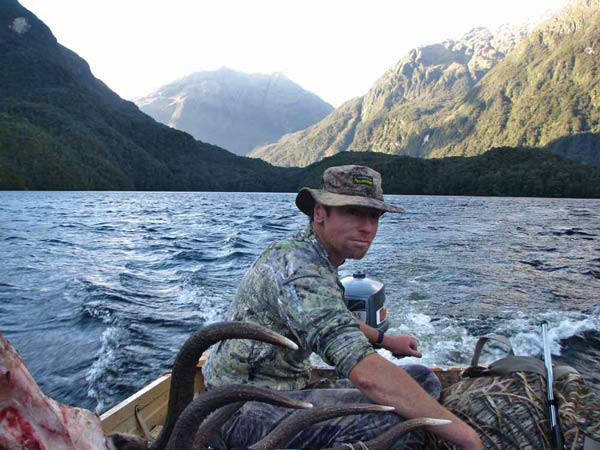
Motoring back down the lake thankful the boat was now carrying the load.
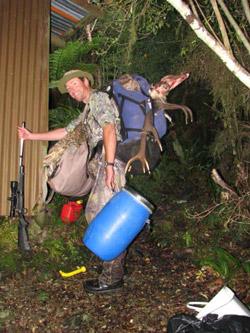
Overloaded carrying the gear back over the isthmus!
Getting to the bottom of the lake not long before dark we met Frank and Neil who were thankfully able to help us carry our gear back over the isthmus to the main lake. From there we were able to sit back in the luxury of the launch. As we chugged our way out of the Middle Fiord, we looked back as the sun set over those magnificent Fiordland mountains and enjoyed a couple of well earned beers!
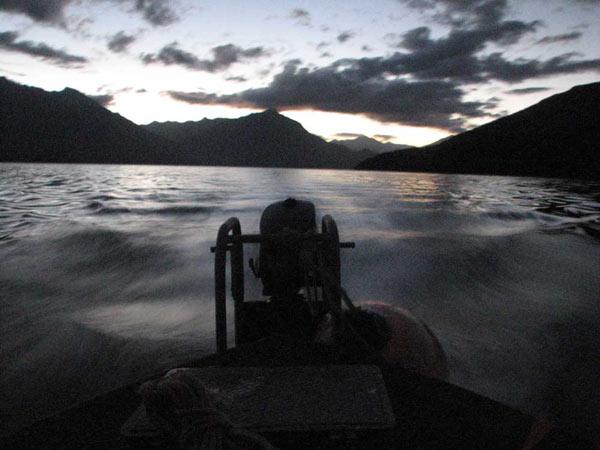
Join the discussion of this article with the author at the [thread=33]Article Discussion Forum[/thread]Greg Duley is editor of NZ Hunter magazine, the number one selling hunting magazine in New Zealand. He and sons Jamie and Willie, and wife Fiona are one of the most passionate and dedicated hunting families in NZ. Greg is renown as the long range hunting expert in his part of the world. Every March/April he'll be found in his beloved Fiordland Mountains, pitting himself against the terrain, weather and remoteness in the pursuit of those magnificent Wapiti (Elk).
By Greg Duley
My annual pilgrimage to the Fiordland Mountains hunting wapiti (elk) during the bugle took me to the Loch Burn block in April this year. I had been guiding deer hunters for the previous month and was really looking forward to a couple of weeks of hunting and exploring on my own account. Hunting in this wilderness area requires extreme fitness and mountain knowledge due to the rugged terrain and atrocious weather that may be encountered. Starting from the edge of Lake Te Anau which is about sea level, you then have to carry everything you need for two weeks on your back 5,000 to 6,000 feet up into the mountains. The wapiti live high and are only driven off the tops by heavy snowfalls in winter. This is the only area in New Zealand where wapiti live. Unfortunately red deer infiltrate the area and then interbreed with the wapiti creating a smaller crossbreed animal, so we try and shoot as many red type animals as we can without disturbing the wapiti too much.
[floatright]

Both my boys were busy at school and the wapiti bugle unfortunately isn't during their holidays. I took Neil Philpott with me again as he's done a couple of wapiti trips with me now. Friends of mine from Te Anau, Frank and Neil, took us across the lake in Neil's launch one afternoon. We spent our last night of comfort for two weeks eating, drinking and sleeping on the launch before climbing over the side and starting our ascent with heavy packs.

Our last luxury breakfast, bacon and eggs before the start of the big climb.
We climbed continuously up through the beech forest for four hours until we broke out onto the open mountain tops south of an area called Howlett's peaks. The weather was windy, squally and pretty cold. We spent a couple of days hunting this mountain range until the weather forecast on the mountain radio said a large storm was approaching.

Neil at our first high camp site with no shelter.
We had seen predominantly red deer in this area and few wapiti type animals. Deciding to head back down to a lower level to weather the storm, we set off back down to the lake edge well north from where we had come up. On the way I culled a couple of red deer, a hind and a young stag. They had appeared up the other side of a steep valley we were skirting around. Sitting down and shooting off my knees I dropped them both with a shot apiece after the rangefinder told me they were 350 yards away using the 160 grain Accubond load. The hind dropped on the spot to the first shot and the stag reared up and rolled backwards to end up right next to her.

A mature red type hind and young stag I culled on our way back off the tops before the first storm.
[/floatright]
After taking their jaws for research purposes we picked up the speed of our descent down through the beech forest as we were running out of daylight. Hitting the lake shore right on dark, we unfortunately had a nightmare of a trip climbing up and down bush covered bluffs by torchlight to make our way around the edge of the lake to the start of a sandy beach. This we followed for a couple of miles which took us around to where we left the main lake and headed over an isthmus (narrow piece of land between two water bodies) to the start of Lake Hankinson. Now after midnight, we launched the dinghy which is kept there, started the outboard motor that Frank had lent us and headed off up the lake in the pitch black. The storm was due to hit in the early hours of the morning, and I wanted to get to the hut at the top end of the lake before it got too rough to travel up it. An hour later we hit the beach at the top end, tied up the boat and carried our gear to the hut, arriving there at 2 a.m., exhausted. We woke up a couple of bow hunters who were in residence and they boiled the billy and made us a cuppa, then we all hit the sack.
It was satisfying to sleep in the next morning in the comfort of the hut as the storm raged around us. It blew itself out by evening, so the next morning we put 10 days food in our packs and headed off up the true left of Canyon Creek to try and find our way onto the tops between there and the Lugar Burn (Burn is a Scottish name for valley). After climbing all day, we broke out of the beech forest and continued up until we reached a terrace just underneath the highest peak and set up camp at 5500 feet. For the next few days we hunted south covering some treacherous terrain until we reached the Howlett's peaks area we had hunted at the beginning of the trip.

Looking down on the isthmus between Lake Te Anau on the left and LakeHankinson on the right from Howlett's peaks.


Interesting country!

Neil watching a mature bull through the spotter.
We saw a reasonable number of wapiti type animals including several young bulls and one mature bull but nothing better than trophies we had previously taken. Packing up the next morning we headed north and dropped down into an area where I had seen a pretty good 15 pointer (8x7) two years previously. The weather was packing in again unfortunately and low cloud and rain made visibility difficult, but the only animal encountered was a 10 pointer (5x5) of average size in the Austral Creek saddle that I managed to get a few photos of.
With another big storm forecast we managed to find a sheltered camp site behind some large rocks on a higher terrace. The wind raged and the rain fell all the following day but our carefully chosen camp didn't let us down and we emerged to a calm but cloudy day the next morning. Heading north again we spent a frustrating day on the more accessible tops above the Lugar Burn flats, bumping into animals in the low cloud and not being able to see how big they were.

A hard to find high sheltered camp site that allowed us to weather the second storm.

The reasonable 10 pointer in the Austral Creek saddle.

The frustrating cloud that made locating animals a matter of luck.
Leaving Neil who was complaining about his knee, I dropped several thousand feet down into the Lugar Burn to try and find my John Nosler presentation Gerber folding knife that Neil had lost two years previously when we were caping his big bull. I found the bones but they were scattered for some distance by avalanches from the heavy winter snows and it was obvious it would be a sheer fluke if I found my knife. I climbed back up and eventually joined Neil who was trying to assess a big bull in the head of the Lugar Burn through my spotter.
The cloud just would not play the game so we had to carry on as the day was getting on. We made a nerve wracking descent down into the start of Canyon Creek?s north cirque (circular ring of cliffs at the head of the valley formed by glaciers), unsure in the poor visibility whether we were going to be able to get to the bottom. Thankfully, by nightfall we had negotiated our way down the last bluff and set up camp in some ribbonwood guts at the start of the best deer country. Through gaps in the cloud we had seen several bulls and cows on the feed slopes beneath the cliffs in the head of the north cirque. When I bugled from the tent that night, some powerful replies echoed back down the valley.
The next morning we headed up onto a prominent ridge that gave us a good view of the north cirque only to find during the night the animals had traveled a sidle track round and into the south cirque. All that was left in the north cirque was a couple of young bulls.

The North cirque of Canyon Creek from the prominent ridge.
Climbing some cliffs and sidling our way around to a good lookout above the south cirque, we dropped down on a herd of wapiti cows and calves with a mature bull in attendance. He was doing his best to keep some red stags at bay, so even though his trophy quality wasn't really good enough we left him covering the cows rather than letting them in on the act.


The bugling wapiti bull and some of his cows.

Neil glassing the little wapiti herd.
Hearing some red roars echoing down from on high to the south, I eventually picked up a large red stag holding four cows high up above the pass out of the south cirque over into the WapitiRiver. I decided he really needed culling so left Neil and his dodgy knee and started the climb. After making good progress for an hour and a half straight up, I tried to cut around onto the rim of the cirque to take me round past the last mountain to the high pass. Unfortunately, a cataract separated us and forced me to have to climb right to the top before I could cut over to the WapitiRiver side to get around it. Finally cresting the top, I looked over and saw a couple of animals feeding on the terrace below me, one a young red stag but the other a nice young 12 point wapiti bull. I took a couple of photos then dropped the red stag with a 160 Accubond but the young wapiti just stood around waiting for his mate. In this remote area, these animals very rarely see humans and the sight of us of doesn't alarm them unduly. Smell, well that's a different story! One whiff of human scent and they travel for miles vacating whole watersheds to get away!



A two-year-old wapiti and red stag grazing together on the tops above LakeSutherland in the WapitiRiver. I culled the young red stag and the young 12 point wapiti stood waiting for his mate to catch up for ages.
I carried on around until the last peak before the pass over to the red stag and cows. Making sure they were still there I looked around until I found a position where I could get a shot but the range was still long with the stag being 618 yards away. I could not drop down through the pass to get closer without being spotted so took the shot off the bipod and a good rest from where I was. Dialing 8.5 moa for the range and 2 moa for the 10mph wind blowing through the pass, I aimed at the crease just behind the shoulder of the stag when he was broadside sniffing one of the cows. One advantage of shooting at this range is that due to the bullet's time of flight you can muscle the rifle back into position and watch it hit. Shot right where I aimed with the 162 grain A-Max load, the stag took a couple of steps and then tumbled which worried me as a few yards further and he would've fallen over a 1,000 foot drop. Luckily he came to rest before that.

Looking 618 yards across the pass to where the red stag was holding four wapiti cows.

The ultimate lightweight long-range hunting rifle, the 7mm Fatso after the shot.

The 11 point red type stag, he has some wapiti blood in him but is not the sort of animal we want breeding.

He came to rest just short of a large freefall thousands of feet down into the South cirque of Canyon Creek.
Taking his head I started the long journey back to where I had left Neil. I got there to find he had headed back to camp and I finally made camp just after dark. We were due to be picked up at the head of the main lake late the next day so the next morning we packed up early and I tied the head and antlers on top of my already heavy pack and we set off down Canyon Creek. The going wasn't too bad until we hit the bottom clearing and the start of the huge cataract from which this valley gets its name. Not having come up this way, we were unsure where the wapiti trail was that would take us around this cataract, or in fact if there even was one. We climbed hand over fist up a large overgrown slip for about an hour which was diabolical with the antlers strapped to my pack getting caught on everything, until we were able to burst over the top and begin sidling. Here and there we picked up bits of old trail and eventually began the descent to bring us back down into the WapitiRiver valley. On down the valley past Hankinson hut and eventually to the shores of LakeHankinson where we had left our dingy tied up. I was thankful to finally be able to drop my load at the lake edge and let the boat do the carrying from here!

Motoring back down the lake thankful the boat was now carrying the load.

Overloaded carrying the gear back over the isthmus!
Getting to the bottom of the lake not long before dark we met Frank and Neil who were thankfully able to help us carry our gear back over the isthmus to the main lake. From there we were able to sit back in the luxury of the launch. As we chugged our way out of the Middle Fiord, we looked back as the sun set over those magnificent Fiordland mountains and enjoyed a couple of well earned beers!

Join the discussion of this article with the author at the [thread=33]Article Discussion Forum[/thread]Greg Duley is editor of NZ Hunter magazine, the number one selling hunting magazine in New Zealand. He and sons Jamie and Willie, and wife Fiona are one of the most passionate and dedicated hunting families in NZ. Greg is renown as the long range hunting expert in his part of the world. Every March/April he'll be found in his beloved Fiordland Mountains, pitting himself against the terrain, weather and remoteness in the pursuit of those magnificent Wapiti (Elk).

